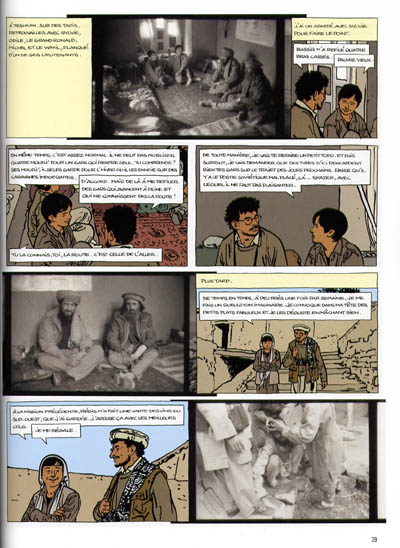Though its achievements are similar to those of Joe Sacco’s Palestine and Safe Area Gorazde (discussed in Part 2 of this series), Le Photographe unfolds in radically different form. The series’ most striking aspect is the unusual combination of documentary photography (Lefèvre's original work) and highly stylized drawings.
The documentary photographs align in sequence like comics panels. They never contain words and leave the verbal narration to the drawn panels, lending the photos a “silent” narrative weight absent from the word-and-drawn-picture panels.

Guibert’s clear line style does not have the overt “cartooniness” of Joe Sacco’s. Pale grays, light browns and faded yellows evoke the desert landscape, further locating Guibert at the opposite end of the aesthetic spectrum from Sacco’s black-and-white underground style. But these drawings fall well within the tradition of European comic books—a tradition more suited for conveying the epic dimensions of Lefvre’s harsh journey.
A more recent example of the power with which comics can narrate real events is Guy Delisle’s Burma Chronicles, originally published in 2007. Delisle is a Quebecois cartoonist and animator who has created comics about his trips to Asia before—Shenzhen in 2000 and Pyongyang in 2003. But in Burma Chronicles, he makes literary progress by developing a spare language reminiscent of the haiku.
Delisle travelled with his wife, who works for Medecins Sans Frontières, to Rangoon, where they lived for a year. The book is composed of somewhat disjointed short stories, building a narrative from microunits rather than a single arc. Delisle’s drawing style—a clear, minimalist line less realistic than Guibert’s—makes use of pale green colors that evoke both the tropical warmth and Burma’s militarized situation.
Burma Chronicles fascinates because it tells us of a life both inside and outside the local conflict; Delisle is basically a stay-at-home dad who works from home drawing comics. (“It is really my job!” he tries to explain to the expat mothers).
Delisle tells a side of the story usually untold: the apparent normality of domestic life in extraordinary circumstances, perceived from a particular point of view. There is no central incident in his narrative; the day-to-day experiences bear witness to life as a foreigner in a country ruled by a repressive regime.
This personal point of view also anchors Palestine, Safe Area Gorazde, and Le Photographe. Like Burma Chronicles, their stories transcend autobiography by functioning as personal dispatches on current events. Rather than survivors' tales, they are tales of survival.
Because their function is not limited to the delivery of news but is also political and aesthetic in scope, these nonfiction efforts examine the boundary between events and how those events are represented. And because they build bridges between objective facts and a literary tradition, these graphic narratives are close cousins of literary journalism.
 [/caption]
Emmanuel Guibert’s and Didier Lefèvre’s Le Photographe moves the field of nonfiction comics toward narrative journalism by revealing the documentary potential of graphic storytelling. Guibert recounts the journey of a photographer (Lefèvre) who records the work of a Medecins Sans Frontières mission in northeastern Afghanistan in 1986. Released in France between 2003 and 2006, the three volumes span 260 pages and follow Lefèvre from Pakistan to Afghanistan and back.
Though its achievements are similar to those of Joe Sacco’s Palestine and Safe Area Gorazde (discussed in
[/caption]
Emmanuel Guibert’s and Didier Lefèvre’s Le Photographe moves the field of nonfiction comics toward narrative journalism by revealing the documentary potential of graphic storytelling. Guibert recounts the journey of a photographer (Lefèvre) who records the work of a Medecins Sans Frontières mission in northeastern Afghanistan in 1986. Released in France between 2003 and 2006, the three volumes span 260 pages and follow Lefèvre from Pakistan to Afghanistan and back.
Though its achievements are similar to those of Joe Sacco’s Palestine and Safe Area Gorazde (discussed in 

